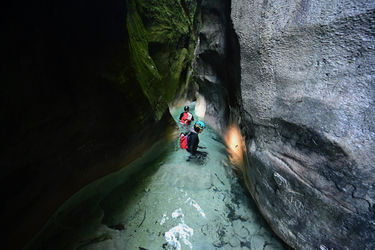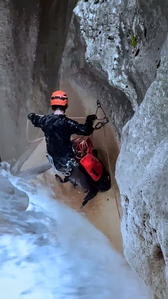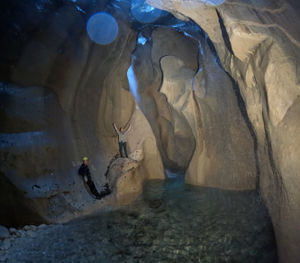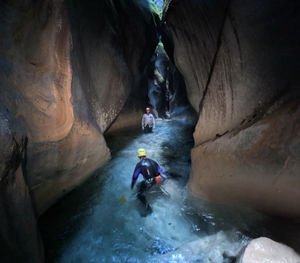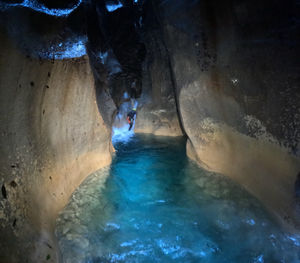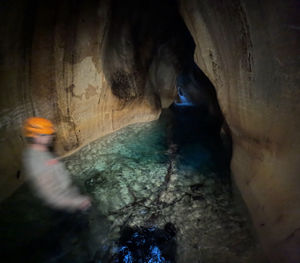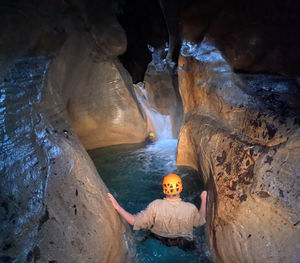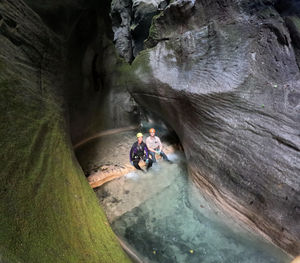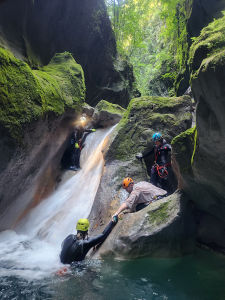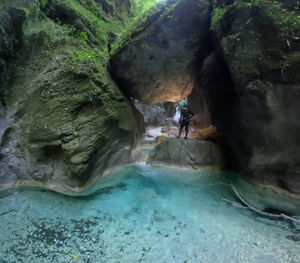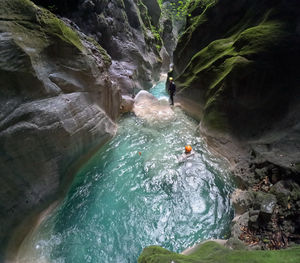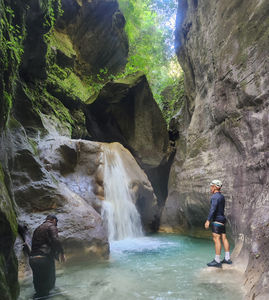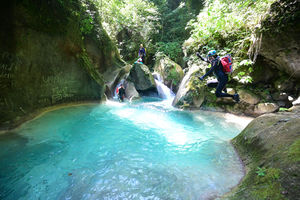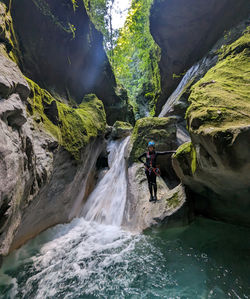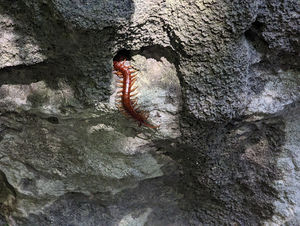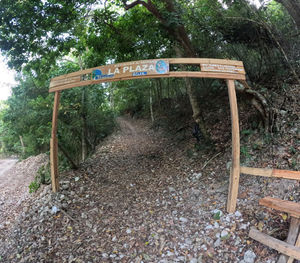Barahuco Canyon
| Rating: | |||||||||||||||||||||||||||||||
|---|---|---|---|---|---|---|---|---|---|---|---|---|---|---|---|---|---|---|---|---|---|---|---|---|---|---|---|---|---|---|---|
| | Raps:9-10, max ↨105ft
Red Tape:No permit required Shuttle:None Vehicle:High Clearance Rock type:Limestone | ||||||||||||||||||||||||||||||
| Start: | |||||||||||||||||||||||||||||||
| Parking: | |||||||||||||||||||||||||||||||
| Condition Reports: | 23 Mar 2025
"What a stunning canyon. The water flowing through sculpted narrows was sublime. There was also flowstone and bats, contributing to a cave-like feel. T |
||||||||||||||||||||||||||||||
| Best season: | Dec-Mar, AVOID Rains
|
||||||||||||||||||||||||||||||
| Regions: | |||||||||||||||||||||||||||||||
Introduction[edit]
The upper part of the Río Bahoruco is a limestone canyon of crystalline water containing a world class section of slot canyon. It is perhaps the best known route in the DR.
Escape is impossible throughout most the route. A waterproof headlamp is recommended for below the final rappel. Although the water is not cold, the canyon is very aquatic and a full 3/2mm wetsuit is recommended. Air and water temps are largely consistent year round. Also, be careful of giant centipedes - these mountains seem to have more giant centipedes than anywhere in the DR, and indeed more than most tropical places, so keep your eyes open at all times - their bite is not dangerous but is extremely painful!
Waterflow picks up considerably just above the final rappel sequence, though it should remain at manageable levels throughout most the dry season. There are no documented technical descents of this canyon during the wet season, but it's suspected that it would be too hazardous for safe passage.
Approach[edit]
You'll need a high clearance vehicle, ideally with 4x4 or all-wheel drive to avoid spinning tires and puncturing a tire on the sharp rocks. The access road has numerous rutted sections that seemingly hold water year-round. If possible, drive to the HC Park location and begin the approach on foot from there.
Parking at the gated Estancia Don Armando is a more secure option if you are concerned about your vehicle and/or valuables, but this adds approximately an additional 20 minutes of hiking. Jorgito Mendez, (829) 691-9796, is a local who has access to the property. You can call or text him, or just ask the local people where to find him. He does not speak English. The land surrounding the canyon is all privately owned. Please be respectful to the locals and consider compensating them for any of their generosity (such as allowing you to park on their property and watching your vehicle).
The approach track navigates a very steep, loose road before transitioning to the use of farming access trails. The path will disappear in sections and then reappear, hopefully, if your navigational skills are half-decent. Eventually you will descend through a fairly thick section of jungle and arrive at the Barahuco spring, and finally, the entry rappel.
Descent[edit]
The entry rappel is the largest in the canyon, at approximately 32m from a tree CL. Be careful not to damage the sensitive stalactite features hanging from the wall. Absent of heavy rains, the flow will be low for the first several rappels. The main canyon above the drop-in is seasonally dry, however wet season conditions could add considerable waterflow. If you look over the lip of R1 and see appreciable flow along the canyon floor, it is recommended to abort the descent.
The remaining rappels are all at or under 23m and bolted, with the exception of one v-thread anchor. Prepare for some challenging downclimbs that may warrant partner assists. Note that the rock outside of the watercourse tends to be incredibly slippery. Caution should be taken at R3, which requires a bit of an exposed move to access.
The final rappel sequence drops you into the depths of Barahuco and will contain much more water than you encountered up canyon. A rebelay is installed high on CR with enough room for one or two people to stand. Accessing the anchor requires stemming over the watercourse.
As of Mar 2025, the pool below this final rappel was around chest height and therefore not dangerous - however, this is subject to change over time as material shifts throughout the canyon.
The canyon climaxes in beauty for about an hour, continuing in darkness through a deep, fully sculpted, cave-like slot that at times is only a meter wide. The jumps, slides, and downclimbs in this section are among the best in the world. In a lifetime of canyoneering, in dozens of seasons of slots, this hallway is likely to be one of the highlights of your life.
The slot gets slightly wider, enough that it is bright and sunny at noon. There is also green moss on the walls. The beauty is surreal.
There's one rappel here, in sunlight, with a set of bolts on the left. The pool below is likely shallow. The obstacle can also be tackled via a slippery and exposed downclimb CR.
All too soon, the slot brings you to an intersection where the canyon goes left and opens greatly. It's more a stream than a slot 15 minutes later when you reach the graffiti and trash-strewn Balneario La Plaza.
Exit[edit]
The exit is a trail from Balneario La Plaza back to your shuttle car. This trail is easy to follow, and crosses the stream many times. It's never more than a few meters from the stream, until the end, where it goes uphill on stream-left for a few minutes to get back to your shuttle car. The road meanders up and down in elevation, and it may be preferred to simply follow the watercourse to its intersection with the road.
Red tape[edit]
You are free to enter these mountains without a guide. Locals may tell you otherwise, but in general are very friendly and happy to see you coming. If you park at one of the houses, be sure you give a few hundred pesos to the family to watch your vehicle. Parking away from a house increases the likelihood of a break-in, which has reportedly happened before.
Beta sites[edit]
Trip reports and media[edit]
https://www.lukaseddy.com/canyons-of-the-dominican-republic
Background[edit]
The first known descent was completed by Nicolas Bera and team in 2021. They descended it once, spending 14 hours on the route. A group member was injured and needed to be partially carried down canyon. Due to a late start they went through the majority of the canyon in total blackness. Several expedition-style bolts were installed.
In 2023, a group of American canyoneers (Michelle Nilles, Hereward Cooper, Dan Kinler, Sarah Jorgenson, Lukas Eddy and Suhei Eddy) visited with almost no beta, and explored the lower section of canyon from the bottom up. They were unable to complete the route from the top down, as the exact drop-in point was unmapped.
In Feb of 2025, two Americans (Eric Van and Nick Clegg) and two DR locals (Nicolas Bera and Wilfrido Bernabel) completed the second known descent of the canyon from the top down. Logistical support was provided by Jorgito Mendez. Several new bolts were installed to enable safe descents at variable flows. The approach route and remaining beta was refined and the canyon was opened to the canyoning community.
